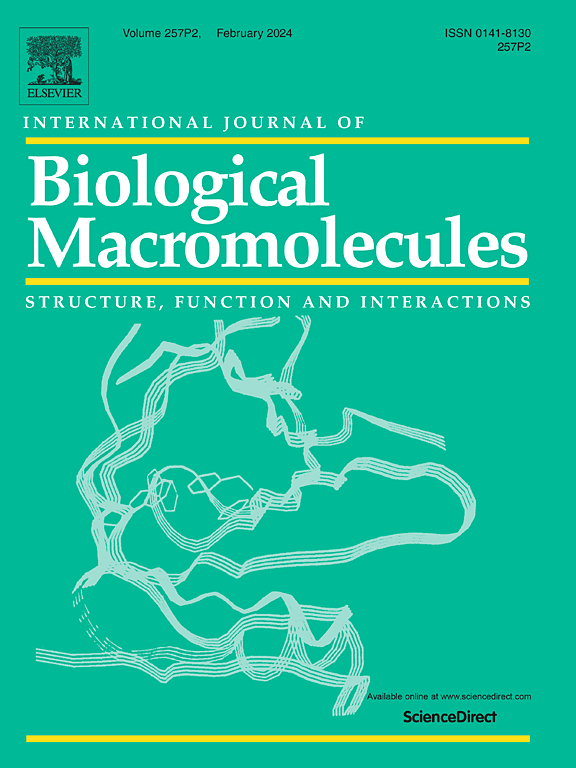用于慢性肠炎治疗的质子束清除TePt @羧甲基纤维素钠纳米酶
IF 8.5
1区 化学
Q1 BIOCHEMISTRY & MOLECULAR BIOLOGY
International Journal of Biological Macromolecules
Pub Date : 2025-07-04
DOI:10.1016/j.ijbiomac.2025.145792
引用次数: 0
摘要
慢性肠炎是一种常见的炎症性疾病,如果不及时治疗,可以发展为急性肠炎甚至肠癌。这种炎症通常与活性氧和活性氮(RONS)的过量产生有关,这会破坏细胞氧化还原稳态,并对细胞和组织造成重大损害。因此,靶向去除炎症部位的ron已成为治疗慢性肠炎的一种有希望的治疗策略。本研究开发了具有良好生理稳定性、生物安全性和抗氧化活性的TePt纳米棒(TP),用于缓解慢性肠炎。TP表现出ph依赖性的酶活性,通过其超氧化物歧化酶和过氧化氢酶活性有效清除活性氧,并在中性条件下清除活性氮。在细胞水平上,TP可以消除细胞内的ron,保护细胞免受氧化应激引起的损伤。在右旋糖酐硫酸钠(DSS)诱导的慢性肠炎小鼠模型中,TP联合羧甲基纤维素钠(CMC)灌胃可显著抑制促炎细胞因子的表达,恢复氧化还原稳态,促进肠道修复,且无明显不良反应。这项研究为抗氧化纳米酶治疗慢性肠炎的设计提供了新的见解。本文章由计算机程序翻译,如有差异,请以英文原文为准。

RONS clearing TePt @ sodium carboxymethyl cellulose nanozymes for chronic enteritis therapy
Chronic enteritis is a prevalent inflammatory disease that can progress to acute enteritis and even intestinal cancer if not promptly treated. This inflammation is often associated with the overproduction of reactive oxygen and nitrogen species (RONS), which disrupt the cellular redox homeostasis and induce significant damage to cells and tissues. Therefore, the targeted removal of RONS at inflamed sites has emerged as a promising therapeutic strategy for chronic enteritis. In this study, the Te![]() Pt nanorods (TP) with good physiological stability, biosafety and antioxidant activities were developed to alleviate chronic enteritis. TP demonstrated pH-dependent enzymatic activities, effectively scavenging reactive oxygen species through their superoxide dismutase and catalase activities, as well as clearing reactive nitrogen species under neutral conditions. At the cellular level, TP could eliminate intracellular RONS and protect cells from oxidative stress-induced damage. In a dextran sulfate sodium (DSS)-induced mouse model of chronic enteritis, the intragastric administration of TP combined with sodium carboxymethyl cellulose (CMC) significantly inhibited the expression of proinflammatory cytokine, restored redox homeostasis, and promoted bowel repair without noticeable adverse effects. This study provides new insights into the design of antioxidant nanozymes for the treatment of chronic enteritis.
Pt nanorods (TP) with good physiological stability, biosafety and antioxidant activities were developed to alleviate chronic enteritis. TP demonstrated pH-dependent enzymatic activities, effectively scavenging reactive oxygen species through their superoxide dismutase and catalase activities, as well as clearing reactive nitrogen species under neutral conditions. At the cellular level, TP could eliminate intracellular RONS and protect cells from oxidative stress-induced damage. In a dextran sulfate sodium (DSS)-induced mouse model of chronic enteritis, the intragastric administration of TP combined with sodium carboxymethyl cellulose (CMC) significantly inhibited the expression of proinflammatory cytokine, restored redox homeostasis, and promoted bowel repair without noticeable adverse effects. This study provides new insights into the design of antioxidant nanozymes for the treatment of chronic enteritis.
求助全文
通过发布文献求助,成功后即可免费获取论文全文。
去求助
来源期刊
CiteScore
13.70
自引率
9.80%
发文量
2728
审稿时长
64 days
期刊介绍:
The International Journal of Biological Macromolecules is a well-established international journal dedicated to research on the chemical and biological aspects of natural macromolecules. Focusing on proteins, macromolecular carbohydrates, glycoproteins, proteoglycans, lignins, biological poly-acids, and nucleic acids, the journal presents the latest findings in molecular structure, properties, biological activities, interactions, modifications, and functional properties. Papers must offer new and novel insights, encompassing related model systems, structural conformational studies, theoretical developments, and analytical techniques. Each paper is required to primarily focus on at least one named biological macromolecule, reflected in the title, abstract, and text.

 求助内容:
求助内容: 应助结果提醒方式:
应助结果提醒方式:


